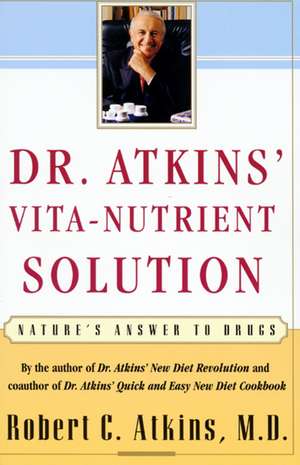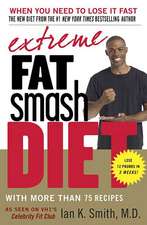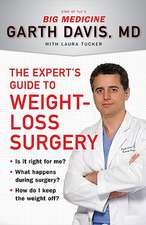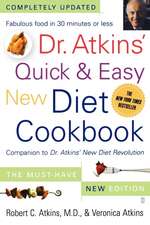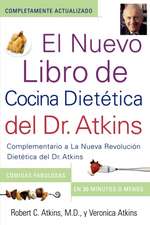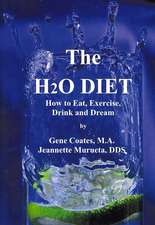Dr. Atkins' Vita-Nutrient Solution: Nature's Answer to Drugs
Autor Robert C. Atkins M.D.en Limba Engleză Paperback – 3 aug 1999
Preț: 165.23 lei
Nou
Puncte Express: 248
Preț estimativ în valută:
31.62€ • 34.34$ • 26.56£
31.62€ • 34.34$ • 26.56£
Carte disponibilă
Livrare economică 01-15 aprilie
Preluare comenzi: 021 569.72.76
Specificații
ISBN-13: 9780684844886
ISBN-10: 0684844885
Pagini: 416
Dimensiuni: 152 x 229 x 25 mm
Greutate: 0.64 kg
Ediția:99000
Editura: ATRIA
Colecția Atria Books
ISBN-10: 0684844885
Pagini: 416
Dimensiuni: 152 x 229 x 25 mm
Greutate: 0.64 kg
Ediția:99000
Editura: ATRIA
Colecția Atria Books
Notă biografică
Robert C. Atkins, M.D., was the founder and medical director of the Atkins Center for Complementary Medicine. A 1951 graduate of the University of Michigan, he received his medical degree from Cornell University Medical School in 1955, and went on to specialize in cardiology. He was a practicing physician for over thirty years and is the author of several books. As a leader in the areas of natural medicine and nutritional pharmacology, he had built an international reputation. He was the recipient of the World Organization of Alternative Medicine's Recognition of Achievement Award and was the National Health Federation's Man of the Year. His many media appearances, where he had discussed diet and health, included "Larry King Live," "Oprah," "CBS This Morning," and "CNBC," among others. Many magazine and newspaper articles have featured his work, and he also had a nationally syndicated radio show. Dr. Atkins was the editor of his own national monthly newsletter, "Dr. Atkins' Health Revelations." He died in April 2003.
Extras
CHAPTER ONE: THE TREATMENT OF CHOICE
Have you ever read or received advertisements proclaiming "Breakthrough!!! Natural treatments your doctor won't tell you about! Safer revolutionary treatment for heart disease, cancer, fatigue or what-have-you"? Perhaps you wondered if the words heralded something important; or perhaps you remained skeptical.
While the details of such ads may or may not be true, there is one thing I can assure you: There are breakthroughs that can restore your health from debilitating illness or, if you are healthy, make you even healthier. They are natural, safe, and nutritious -- and they have not been adopted by mainstream medicine.
THE GRATIFICATIONS OF NUTRITIONAL WEAPONS
For the past quarter century I have devoted my medical career to developing and teaching others about complementary medicine, a somewhat revolutionary school of thought in which the doctor tries, whenever possible, to replace risky medical and surgical interventions with safe, gentle, and nourishing efforts to restore the patient's health. The focal point of this activity is the Atkins Center for Complementary Medicine, where I and my staff of health professionals treat thousands of patients with a wide spectrum of health problems that range from the life-threatening to simple prevention. In that time span, I have witnessed the ability of vita-nutrient therapy to overcome illnesses of just about every kind. This kind of treatment is growing so exponentially that even now I am constantly amazed at its impressive successes.
To give you the flavor of the exhilarating satisfaction I get from practicing this new kind of medicine; listen to the story of my patient Marie Speller. An eleven-year-old who had been recently diagnosed with juvenile diabetes, she had been prescribed two varieties of insulin. Doctors are traditionally taught that juvenile diabetes carries with it a life sentence requiring insulin. However, I had learned from treating other diabetic patients that if one of the lesser-known vita-nutrients, calcium AEP, is given during the first year of this illness, the illness can be reversed. I put Marie on a vita-nutrient program, and we were able to lower her insulin dose, week by week, until six months later she stopped taking the drug completely. Her blood sugar levels were virtually normal and have remained so for the past two years, at which time her pancreas responded to a carbohydrate meal with a normal output of insulin.
When I first saw Ron Barlow, he could not pass his high school exams and had to be put in a special tutorial class. Why? Because the radiation therapy he received to remove a cancerous growth in his brain had damaged that organ. Records showed that dozens of other youngsters treated as Ron had been had never gone to college.
I gave Ron every vita-nutrient I knew that helped brain function. A few weeks later, the young man, who had never gotten as much as a "D" on an exam since his radiation, received an "A" on his midterm. His teachers were astounded. Ron was later accepted at a good college, where he is now doing very well.
CASE HISTORIES PROVIDE SCIENTIFIC DATA
While these stories are certainly dramatic, others may be more illustrative because they are typical of 80-90 percent of patients with similar problems. For example, Jack Spanfield came to the Atkins Center at age forty-three with an eleven-year history of ulcerative colitis. Its painful symptoms include frequent bloody diarrhea, mucus, and cramps. Jack had failed to benefit from the strongest of medications and required two painkilling enemas every day when I first examined him. After two weeks of targeted vita-nutrient therapy and a sugarless diet, he began to improve. Within six weeks his bowel function was completely normal, and within three months he was off all medications.
Marian Longstaff, a seventy-four-year-old woman, had had psoriasis for seventeen years. Even with considerable doses of prednisone, she was suffering from itchy, scaly patches on her scalp, knees, elbows, and arms. She improved within six weeks on a vita-nutrient program, and in seven months the scales, the itching, and the prednisone were all gone.
Isabel Palmer, a forty-one-year-old woman, had diabetes, asthma, migraine headaches, and high blood pressure. After a few months on vita-nutrients targeted specifically to all of these conditions, every problem was gone or virtually gone.
Karen Wickman, a forty-eight-year-old woman with a complete absence of hair (alopecia areata), complained of fatigue, memory loss, and high cholesterol, for which she took a statin drug. After a few months of taking vita-nutrients she could buy in a health food store, her cholesterol dropped sixty points, even without the medications. Her memory and alertness improved, and best of all, her hair started growing in!
Ronald Dawson, age thirty-six, had migraines so severe that he had been on disability for four years. Within a month of starting vita-nutrients, he was off three different kinds of strong medications and his migraines had stopped.
The great majority of patients I see at the Atkins Center could also tell you stories of how they benefited by upgrading their nutritional intake. Yet most had been told by well-trained specialists that nothing else -- besides drugs -- could help them. Don't believe anyone who tells you that! It simply means that nothing can be done within medicine's officially sanctioned surgical and pharmaceutical boundaries. Beyond these narrow confines, however, is a universe of scientifically validated treatments -- vitamins, minerals, fatty acids, amino acids, enzymes, and other biochemical substances that exist naturally in our bodies or diet -- which the medical establishment chooses not to recognize.
Taking nutritional supplements is not new. But what is new now is that medical science itself, through research and experiment, is beginning to legitimize the nonpharmaceutical prescriptions used for so long by progressive health practitioners. Together, published studies and real-world clinical evidence prove that a wide range of these nourishing compounds can overcome illness as well as (and usually better than) the best drugs and invasive surgeries that money can buy.
The patients I have described refused the conventional wisdom of the medical establishment. In so doing, they recovered far beyond anyone's expectations, simply by eating properly and taking nutrient supplements. From headache to hypertension, diarrhea to diabetes, most modern-day illnesses are diet-related disorders. They result from eating incorrectly and not ingesting enough of the nourishing, naturally present biochemicals that optimize vital bodily functions. Successful treatment of illness results from replenishing the supply of these substances through diet and nutritional supplements.
TREATMENT OF CHOICE DEFINED
The vita-nutrient solution isn't just a supporting actor for successful therapy; in most instances the vita-nutrients themselves should be the treatment of choice. This concept is so important that I should define it here. The phrase refers to the first option that a doctor selects to treat the condition in question. It is the "gold standard" against which other treatments must be compared.
In medical school I was taught that "treatment of choice" status should be given to therapies that have the highest benefit-to-risk ratio. Medical educators recognized that the number one choice should both favorably affect the illness (the benefit) and should have relative freedom from side effects (the risk). It's easy to understand why the benefit-to-risk ratio is the hallmark for choosing one therapy over others. But what many fail to recognize is that when this same criterion is applied, virtually all patients would be far better off with nutritional treatments.
In an ideal world, the medical profession would select treatments of choice strictly on these sensible criteria. Nutrients, however, are rarely given the consideration they deserve -- even as a second line of defense. As a result, we are all victims of a tragic double standard that favors prescription drugs, along with their high cost and risk of unwanted (but not unexpected) side effects.
I would match a vita-nutrient solution against a combination of pharmaceuticals any day. Take the need to fight water retention, something many women would like to do every month and, more seriously, a major goal when treating high blood pressure or congestive heart failure. My treatment of choice would be taurine, an amino acid that promotes fluid excretion by restoring a natural balance between potassium and sodium, the minerals that govern how much fluid our tissues retain. As a bonus, it contributes to maintaining a regular heart rhythm and the heart's ability to contract, among many other physiological functions. In its required therapeutic dosage, taurine has absolutely no undesirable side effects.
By contrast, mainstream medicine's treatment of choice for fluid retention is the diuretic, a drug that also encourages excretion -- not by allowing our cells to function more healthfully, but by impairing the kidneys' ability to reabsorb and hold on to vitally necessary minerals. In the process, diuretics elevate blood sugar, cholesterol, and triglycerides; disrupt heart rhythm; increase uric acid levels; and drain the body of trace minerals and other nutrients.
All things considered, which treatment would you prefer?
To give another example, heart disease, our nation's number one killer, arises in large part from atherosclerosis, the condition that results when our bodies deposit plaque within the walls of our vital arteries. Conventional medicine identified cholesterol as the enemy and has been waging a public health campaign to reduce the national cholesterol count by all means possible, including the widespread dispensation of cholesterol-lowering drugs. These medications may reduce the proportion of fats in the bloodstream, but should we accept a victory at any price? Drug treatments have proved successful only two times in eighty trials. Most of these studies have shown that more people die sooner from causes other than heart disease if they take these medications than if they aren't treated at all.
I certainly don't agree with the use of pharmaceuticals to lower cholesterol, because it may be only the harbinger, not the cause, of heart disease. Cholesterol is too valuable for us to remove it deliberately from our diets. To lower its concentration in the blood, however, nothing is more effective than pantethine, a derivative of the B-complex nutrient pantothenic acid. At least eight studies agree that pantethine impressively lowers triglycerides, low-density lipoprotein (LDL, the "bad" cholesterol), and total cholesterol while increasing high-density lipoprotein (HDL, the artery-cleansing "good" cholesterol).
You will not read about pantethine in standard cardiovascular textbooks, and you'll be hard-pressed to find a physician familiar with it. Instead, cardiac specialists typically wait until the anticholesterol drugs fail, then begin to consider surgical solutions -- a heart bypass, angioplasty, maybe a heart transplant. Their records of success are no more impressive than those of the cholesterol-lowering drugs. If the field of cardiology took into account only the work of its own scientists, it would soon discover other choice solutions: nutrients like magnesium, coenzyme Q10, and carnitine. These substances strengthen the heart and, as part of a total therapy, can eliminate the need for a heart operation.
Literally dozens of other nutrients offer smarter fixes for the health problems that prescription drugs presume to address. Not all of them are documented as solidly as I'm sure they will be one day, but in the absence of published research evidence, we have the equally persuasive and conclusive experience of hands-on health practitioners. These are far-thinking professionals who prescribe nutritional supplements almost daily and see the results directly on their patients.
ENABLERS VS. BLOCKERS: COMPLEMENTARY THERAPY
Vita-nutrients and pharmaceuticals need not be rivals. The fact is, both accomplish many of the same things -- they can decrease blood sugar, raise your spirits, make you drowsy, control heart rate, minimize inflammation, or any number of other responses. The difference is in how they work. Nutrients are enablers: they give your body a chance to do what it needs to do by facilitating a natural physiological process, thus causing the body to function better. Usually the impact isn't immediate; they perform best over the long term. In contrast, drugs, which can master acute situations, become problematic when used chronically. Why? Because they are disablers, or blocking agents. They work by preventing a normal process from taking place, usually an enzyme performing a vital role. For drugs to work, there must be a disease; only in a disease state can one hope to benefit from blocking an essential life function. Think about this: Drugs, by their inherent nature, can play no role in health care -- only in sickness care.
Though drugs almost always carry an inherent risk (which is seldom true for nutrients), their use isn't necessarily hazardous or detrimental. With diametrically opposed mechanisms of action, medications and vita-nutrients can and should work in harmony. Long ago I selected the term "complementary medicine" to designate a health care system that takes advantage of this happy synergy. In many instances we need to block or abruptly change a bodily function. At other times we need to achieve a response that no nutrient can perform. Many of my patients must continue to take prescription drugs, but because I emphasize nutrient therapy, most of them require fewer medications, and in smaller, far safer dosages. The best medical care will always emphasize enabling our bodies to heal themselves. How can it be appropriate for the first treatment of choice to be something that's potentially harmful when there are safer, equally effective alternatives?
Why, then, do so many of our doctors prescribe pharmaceuticals so exclusively that they give you the impression that enabling substances do not exist? One answer is that the pharmaceutical approach is all that is being taught to our doctors-in-training. For more insight, a brief understanding of the history of nutrition may be helpful to you.
A BRIEF HISTORY OF NUTRITION
Modern medical education has never truly appreciated nutrition, even though it is just as crucial as anatomy, physiology, biochemistry, and pharmacology to understanding human health. Because nutrition is the only one of these basic disciplines that medical schools do not typically offer in their curricula, nature's pharmacy has received the short end of the therapeutic stick from the start. Even with the explosion of nutritional research in the last decade, the newest edition of Cecil's Textbook of Medicine, the authoritative reference work that is a medical student's bible, still fails to mention the Harvard studies that prove that vitamin E cuts the incidence of heart disease by almost 50 percent. Nor does it mention more than a handful of the studies you'll read about in this book.
How did this come about? A hundred years ago or so, nutritional scientists believed that germs and other microbes caused all of our sickness and disease. The existence of very small molecules with essential health-promoting roles (later dubbed vitamins) was a new, even revolutionary theory. By the first decades of the 1900s, researchers had confirmed that people could be afflicted with deficiency diseases, and in rapid succession we learned that vitamin A cured night blindness, vitamin D prevented rickets, scurvy disappeared with a small dosage of vitamin C, and so on. The recognition of deficiency diseases was a major breakthrough that established nutrition as a medical science. Ironically enough, though, these remarkable discoveries would later create major obstacles to the broader approach to health care that works so effectively today.
From the beginning, nutritional research was always focused on the concept of "deficiency." A nutrient's value was measured only in terms of the consequences of its absence. If the lack did not lead to a deficiency disease, the nutrient tended to be dismissed as valueless and unimportant. It certainly didn't qualify to be labeled "essential," a title reserved for the vitamins and minerals that the body could not manufacture on its own and could not do without. Some substances provided beneficial effects only under certain circumstances, which called for the invention of a "conditionally essential" category that, in my view, established the basis for today's nutritional pharmacology. The conditions under which nutrients became "essential" generally are associated with sickness, which plants the notion of nutritional therapy squarely in the medical profession's lap.
Unfortunately, mainstream medical science failed to recognize this point, and decades passed before anyone posed the more pertinent questions: What roles does a given nutrient play in the body? How much of it do we need? What is the optimum amount of this nutrient? (Every constituent of our body -- sodium, iron, glucose -- has an optimum level.) The answers would probably reveal that most of us fall in the low end of the nutrient intake curve, ingesting only marginal amounts that are barely above what mainstream medicine considers a deficiency. True, the normal intake of vitamin B1 might be sufficient to prevent beriberi, but is it enough to prevent a learning disability or cardiomyopathy? As you'll learn later on, giving B1 supplements to children whose stores are low can increase their capacity to learn by 25 percent. Nevertheless, medical orthodoxy won't even consider the possibility that the inability to concentrate could in fact be a symptom of a suboptimum B1 level.
BEYOND DEFICIENCY
Once researchers established all the deficiency diseases they were willing to consider, medicine's interest in nutrients waned. By the 1940s the story seemed so finished that Oxford University turned down a large endowment to conduct nutrition research. The gist of the school's response? "We've already identified all the essential nutrients. What more is there to do?"
The task of educating the public was taken up by lay nutritionists like Gaylord Hauser, Adelle Davis, and Carlton Fredericks (each of whom personally contributed to my pursuit of nutrition in medicine). They spread the word that nutritional supplements were proving to be safe, and higher amounts could often bring about striking health benefits. In clinical experience, Frederick Klenner, M.D., showed that extremely high doses of vitamin C could treat a wide variety of ailments. (Subsequently, Nobelist Linus Pauling, Ph.D., influenced millions of people to take such doses preventively.)
But it was the publication of Biochemical Individuality in 1956 that marked the birth of modern therapeutic and preventive nutrition. Roger Williams, Ph.D., the author of this landmark book, showed that our nutritional needs are as unique as our fingerprints and that an off-the-rack, one-diet-fits-all nutrient standard missed the point entirely. Alcoholism, diabetes, mental illness, arthritis, and many other health problems can result when we fail to obtain optimal amounts of nutrients, Williams argued. He even went so far as to suggest that people take vitamins and minerals in doses well beyond the recommended dietary allowances (RDAs), which by then had become the definitive standard of human nutritional needs.
Perhaps the lay nutrition movement infuriated the arbiters of official nutritional policy. They dug in their heels, maintaining the position that we get all the nutrients we need from food. Supplements, they claimed, were unnecessary unless the person was undergoing unusual stress or dietary restrictions. Thus the nutritional old guard continues to stick to its original deficiency-oriented beliefs, in spite of the fact that international research demonstrates one major clinical success after another. The debate is hardly academic. Such intransigence, to give an example, has kept expectant mothers from consuming the amount of the B-complex nutrient folic acid necessary to prevent fatal or crippling spinal birth defects.
If we are to realize the full power of nutrition-based medicine, we must look beyond deficiency. Only then can we solve the riddles of cancer, heart disease, and our other degenerative diseases. It is an achievable goal, but only if we understand that most of the power of vita-nutrients is derived from doses that have nothing to do with merely correcting a deficiency. When essentiality is applied as the yardstick, we're limited to a handful of vitamins and minerals, less than half of the amino acids, and two essential fatty acids. In the past two decades, however, we've discovered a host of nonessential (by the official definition) nourishing substances that play roles in the body so vital that, for all intents and purposes, we would all suffer without them. They are the nutritional equivalents of the automobile or electricity. We would not die without them, but without them we cannot regain good health, once it is lost. These vita-nutrients, for the proficient user, are indeed the tools of healing.
Copyright © 1998 by Robert C. Atkins, M.D.
Have you ever read or received advertisements proclaiming "Breakthrough!!! Natural treatments your doctor won't tell you about! Safer revolutionary treatment for heart disease, cancer, fatigue or what-have-you"? Perhaps you wondered if the words heralded something important; or perhaps you remained skeptical.
While the details of such ads may or may not be true, there is one thing I can assure you: There are breakthroughs that can restore your health from debilitating illness or, if you are healthy, make you even healthier. They are natural, safe, and nutritious -- and they have not been adopted by mainstream medicine.
THE GRATIFICATIONS OF NUTRITIONAL WEAPONS
For the past quarter century I have devoted my medical career to developing and teaching others about complementary medicine, a somewhat revolutionary school of thought in which the doctor tries, whenever possible, to replace risky medical and surgical interventions with safe, gentle, and nourishing efforts to restore the patient's health. The focal point of this activity is the Atkins Center for Complementary Medicine, where I and my staff of health professionals treat thousands of patients with a wide spectrum of health problems that range from the life-threatening to simple prevention. In that time span, I have witnessed the ability of vita-nutrient therapy to overcome illnesses of just about every kind. This kind of treatment is growing so exponentially that even now I am constantly amazed at its impressive successes.
To give you the flavor of the exhilarating satisfaction I get from practicing this new kind of medicine; listen to the story of my patient Marie Speller. An eleven-year-old who had been recently diagnosed with juvenile diabetes, she had been prescribed two varieties of insulin. Doctors are traditionally taught that juvenile diabetes carries with it a life sentence requiring insulin. However, I had learned from treating other diabetic patients that if one of the lesser-known vita-nutrients, calcium AEP, is given during the first year of this illness, the illness can be reversed. I put Marie on a vita-nutrient program, and we were able to lower her insulin dose, week by week, until six months later she stopped taking the drug completely. Her blood sugar levels were virtually normal and have remained so for the past two years, at which time her pancreas responded to a carbohydrate meal with a normal output of insulin.
When I first saw Ron Barlow, he could not pass his high school exams and had to be put in a special tutorial class. Why? Because the radiation therapy he received to remove a cancerous growth in his brain had damaged that organ. Records showed that dozens of other youngsters treated as Ron had been had never gone to college.
I gave Ron every vita-nutrient I knew that helped brain function. A few weeks later, the young man, who had never gotten as much as a "D" on an exam since his radiation, received an "A" on his midterm. His teachers were astounded. Ron was later accepted at a good college, where he is now doing very well.
CASE HISTORIES PROVIDE SCIENTIFIC DATA
While these stories are certainly dramatic, others may be more illustrative because they are typical of 80-90 percent of patients with similar problems. For example, Jack Spanfield came to the Atkins Center at age forty-three with an eleven-year history of ulcerative colitis. Its painful symptoms include frequent bloody diarrhea, mucus, and cramps. Jack had failed to benefit from the strongest of medications and required two painkilling enemas every day when I first examined him. After two weeks of targeted vita-nutrient therapy and a sugarless diet, he began to improve. Within six weeks his bowel function was completely normal, and within three months he was off all medications.
Marian Longstaff, a seventy-four-year-old woman, had had psoriasis for seventeen years. Even with considerable doses of prednisone, she was suffering from itchy, scaly patches on her scalp, knees, elbows, and arms. She improved within six weeks on a vita-nutrient program, and in seven months the scales, the itching, and the prednisone were all gone.
Isabel Palmer, a forty-one-year-old woman, had diabetes, asthma, migraine headaches, and high blood pressure. After a few months on vita-nutrients targeted specifically to all of these conditions, every problem was gone or virtually gone.
Karen Wickman, a forty-eight-year-old woman with a complete absence of hair (alopecia areata), complained of fatigue, memory loss, and high cholesterol, for which she took a statin drug. After a few months of taking vita-nutrients she could buy in a health food store, her cholesterol dropped sixty points, even without the medications. Her memory and alertness improved, and best of all, her hair started growing in!
Ronald Dawson, age thirty-six, had migraines so severe that he had been on disability for four years. Within a month of starting vita-nutrients, he was off three different kinds of strong medications and his migraines had stopped.
The great majority of patients I see at the Atkins Center could also tell you stories of how they benefited by upgrading their nutritional intake. Yet most had been told by well-trained specialists that nothing else -- besides drugs -- could help them. Don't believe anyone who tells you that! It simply means that nothing can be done within medicine's officially sanctioned surgical and pharmaceutical boundaries. Beyond these narrow confines, however, is a universe of scientifically validated treatments -- vitamins, minerals, fatty acids, amino acids, enzymes, and other biochemical substances that exist naturally in our bodies or diet -- which the medical establishment chooses not to recognize.
Taking nutritional supplements is not new. But what is new now is that medical science itself, through research and experiment, is beginning to legitimize the nonpharmaceutical prescriptions used for so long by progressive health practitioners. Together, published studies and real-world clinical evidence prove that a wide range of these nourishing compounds can overcome illness as well as (and usually better than) the best drugs and invasive surgeries that money can buy.
The patients I have described refused the conventional wisdom of the medical establishment. In so doing, they recovered far beyond anyone's expectations, simply by eating properly and taking nutrient supplements. From headache to hypertension, diarrhea to diabetes, most modern-day illnesses are diet-related disorders. They result from eating incorrectly and not ingesting enough of the nourishing, naturally present biochemicals that optimize vital bodily functions. Successful treatment of illness results from replenishing the supply of these substances through diet and nutritional supplements.
TREATMENT OF CHOICE DEFINED
The vita-nutrient solution isn't just a supporting actor for successful therapy; in most instances the vita-nutrients themselves should be the treatment of choice. This concept is so important that I should define it here. The phrase refers to the first option that a doctor selects to treat the condition in question. It is the "gold standard" against which other treatments must be compared.
In medical school I was taught that "treatment of choice" status should be given to therapies that have the highest benefit-to-risk ratio. Medical educators recognized that the number one choice should both favorably affect the illness (the benefit) and should have relative freedom from side effects (the risk). It's easy to understand why the benefit-to-risk ratio is the hallmark for choosing one therapy over others. But what many fail to recognize is that when this same criterion is applied, virtually all patients would be far better off with nutritional treatments.
In an ideal world, the medical profession would select treatments of choice strictly on these sensible criteria. Nutrients, however, are rarely given the consideration they deserve -- even as a second line of defense. As a result, we are all victims of a tragic double standard that favors prescription drugs, along with their high cost and risk of unwanted (but not unexpected) side effects.
I would match a vita-nutrient solution against a combination of pharmaceuticals any day. Take the need to fight water retention, something many women would like to do every month and, more seriously, a major goal when treating high blood pressure or congestive heart failure. My treatment of choice would be taurine, an amino acid that promotes fluid excretion by restoring a natural balance between potassium and sodium, the minerals that govern how much fluid our tissues retain. As a bonus, it contributes to maintaining a regular heart rhythm and the heart's ability to contract, among many other physiological functions. In its required therapeutic dosage, taurine has absolutely no undesirable side effects.
By contrast, mainstream medicine's treatment of choice for fluid retention is the diuretic, a drug that also encourages excretion -- not by allowing our cells to function more healthfully, but by impairing the kidneys' ability to reabsorb and hold on to vitally necessary minerals. In the process, diuretics elevate blood sugar, cholesterol, and triglycerides; disrupt heart rhythm; increase uric acid levels; and drain the body of trace minerals and other nutrients.
All things considered, which treatment would you prefer?
To give another example, heart disease, our nation's number one killer, arises in large part from atherosclerosis, the condition that results when our bodies deposit plaque within the walls of our vital arteries. Conventional medicine identified cholesterol as the enemy and has been waging a public health campaign to reduce the national cholesterol count by all means possible, including the widespread dispensation of cholesterol-lowering drugs. These medications may reduce the proportion of fats in the bloodstream, but should we accept a victory at any price? Drug treatments have proved successful only two times in eighty trials. Most of these studies have shown that more people die sooner from causes other than heart disease if they take these medications than if they aren't treated at all.
I certainly don't agree with the use of pharmaceuticals to lower cholesterol, because it may be only the harbinger, not the cause, of heart disease. Cholesterol is too valuable for us to remove it deliberately from our diets. To lower its concentration in the blood, however, nothing is more effective than pantethine, a derivative of the B-complex nutrient pantothenic acid. At least eight studies agree that pantethine impressively lowers triglycerides, low-density lipoprotein (LDL, the "bad" cholesterol), and total cholesterol while increasing high-density lipoprotein (HDL, the artery-cleansing "good" cholesterol).
You will not read about pantethine in standard cardiovascular textbooks, and you'll be hard-pressed to find a physician familiar with it. Instead, cardiac specialists typically wait until the anticholesterol drugs fail, then begin to consider surgical solutions -- a heart bypass, angioplasty, maybe a heart transplant. Their records of success are no more impressive than those of the cholesterol-lowering drugs. If the field of cardiology took into account only the work of its own scientists, it would soon discover other choice solutions: nutrients like magnesium, coenzyme Q10, and carnitine. These substances strengthen the heart and, as part of a total therapy, can eliminate the need for a heart operation.
Literally dozens of other nutrients offer smarter fixes for the health problems that prescription drugs presume to address. Not all of them are documented as solidly as I'm sure they will be one day, but in the absence of published research evidence, we have the equally persuasive and conclusive experience of hands-on health practitioners. These are far-thinking professionals who prescribe nutritional supplements almost daily and see the results directly on their patients.
ENABLERS VS. BLOCKERS: COMPLEMENTARY THERAPY
Vita-nutrients and pharmaceuticals need not be rivals. The fact is, both accomplish many of the same things -- they can decrease blood sugar, raise your spirits, make you drowsy, control heart rate, minimize inflammation, or any number of other responses. The difference is in how they work. Nutrients are enablers: they give your body a chance to do what it needs to do by facilitating a natural physiological process, thus causing the body to function better. Usually the impact isn't immediate; they perform best over the long term. In contrast, drugs, which can master acute situations, become problematic when used chronically. Why? Because they are disablers, or blocking agents. They work by preventing a normal process from taking place, usually an enzyme performing a vital role. For drugs to work, there must be a disease; only in a disease state can one hope to benefit from blocking an essential life function. Think about this: Drugs, by their inherent nature, can play no role in health care -- only in sickness care.
Though drugs almost always carry an inherent risk (which is seldom true for nutrients), their use isn't necessarily hazardous or detrimental. With diametrically opposed mechanisms of action, medications and vita-nutrients can and should work in harmony. Long ago I selected the term "complementary medicine" to designate a health care system that takes advantage of this happy synergy. In many instances we need to block or abruptly change a bodily function. At other times we need to achieve a response that no nutrient can perform. Many of my patients must continue to take prescription drugs, but because I emphasize nutrient therapy, most of them require fewer medications, and in smaller, far safer dosages. The best medical care will always emphasize enabling our bodies to heal themselves. How can it be appropriate for the first treatment of choice to be something that's potentially harmful when there are safer, equally effective alternatives?
Why, then, do so many of our doctors prescribe pharmaceuticals so exclusively that they give you the impression that enabling substances do not exist? One answer is that the pharmaceutical approach is all that is being taught to our doctors-in-training. For more insight, a brief understanding of the history of nutrition may be helpful to you.
A BRIEF HISTORY OF NUTRITION
Modern medical education has never truly appreciated nutrition, even though it is just as crucial as anatomy, physiology, biochemistry, and pharmacology to understanding human health. Because nutrition is the only one of these basic disciplines that medical schools do not typically offer in their curricula, nature's pharmacy has received the short end of the therapeutic stick from the start. Even with the explosion of nutritional research in the last decade, the newest edition of Cecil's Textbook of Medicine, the authoritative reference work that is a medical student's bible, still fails to mention the Harvard studies that prove that vitamin E cuts the incidence of heart disease by almost 50 percent. Nor does it mention more than a handful of the studies you'll read about in this book.
How did this come about? A hundred years ago or so, nutritional scientists believed that germs and other microbes caused all of our sickness and disease. The existence of very small molecules with essential health-promoting roles (later dubbed vitamins) was a new, even revolutionary theory. By the first decades of the 1900s, researchers had confirmed that people could be afflicted with deficiency diseases, and in rapid succession we learned that vitamin A cured night blindness, vitamin D prevented rickets, scurvy disappeared with a small dosage of vitamin C, and so on. The recognition of deficiency diseases was a major breakthrough that established nutrition as a medical science. Ironically enough, though, these remarkable discoveries would later create major obstacles to the broader approach to health care that works so effectively today.
From the beginning, nutritional research was always focused on the concept of "deficiency." A nutrient's value was measured only in terms of the consequences of its absence. If the lack did not lead to a deficiency disease, the nutrient tended to be dismissed as valueless and unimportant. It certainly didn't qualify to be labeled "essential," a title reserved for the vitamins and minerals that the body could not manufacture on its own and could not do without. Some substances provided beneficial effects only under certain circumstances, which called for the invention of a "conditionally essential" category that, in my view, established the basis for today's nutritional pharmacology. The conditions under which nutrients became "essential" generally are associated with sickness, which plants the notion of nutritional therapy squarely in the medical profession's lap.
Unfortunately, mainstream medical science failed to recognize this point, and decades passed before anyone posed the more pertinent questions: What roles does a given nutrient play in the body? How much of it do we need? What is the optimum amount of this nutrient? (Every constituent of our body -- sodium, iron, glucose -- has an optimum level.) The answers would probably reveal that most of us fall in the low end of the nutrient intake curve, ingesting only marginal amounts that are barely above what mainstream medicine considers a deficiency. True, the normal intake of vitamin B1 might be sufficient to prevent beriberi, but is it enough to prevent a learning disability or cardiomyopathy? As you'll learn later on, giving B1 supplements to children whose stores are low can increase their capacity to learn by 25 percent. Nevertheless, medical orthodoxy won't even consider the possibility that the inability to concentrate could in fact be a symptom of a suboptimum B1 level.
BEYOND DEFICIENCY
Once researchers established all the deficiency diseases they were willing to consider, medicine's interest in nutrients waned. By the 1940s the story seemed so finished that Oxford University turned down a large endowment to conduct nutrition research. The gist of the school's response? "We've already identified all the essential nutrients. What more is there to do?"
The task of educating the public was taken up by lay nutritionists like Gaylord Hauser, Adelle Davis, and Carlton Fredericks (each of whom personally contributed to my pursuit of nutrition in medicine). They spread the word that nutritional supplements were proving to be safe, and higher amounts could often bring about striking health benefits. In clinical experience, Frederick Klenner, M.D., showed that extremely high doses of vitamin C could treat a wide variety of ailments. (Subsequently, Nobelist Linus Pauling, Ph.D., influenced millions of people to take such doses preventively.)
But it was the publication of Biochemical Individuality in 1956 that marked the birth of modern therapeutic and preventive nutrition. Roger Williams, Ph.D., the author of this landmark book, showed that our nutritional needs are as unique as our fingerprints and that an off-the-rack, one-diet-fits-all nutrient standard missed the point entirely. Alcoholism, diabetes, mental illness, arthritis, and many other health problems can result when we fail to obtain optimal amounts of nutrients, Williams argued. He even went so far as to suggest that people take vitamins and minerals in doses well beyond the recommended dietary allowances (RDAs), which by then had become the definitive standard of human nutritional needs.
Perhaps the lay nutrition movement infuriated the arbiters of official nutritional policy. They dug in their heels, maintaining the position that we get all the nutrients we need from food. Supplements, they claimed, were unnecessary unless the person was undergoing unusual stress or dietary restrictions. Thus the nutritional old guard continues to stick to its original deficiency-oriented beliefs, in spite of the fact that international research demonstrates one major clinical success after another. The debate is hardly academic. Such intransigence, to give an example, has kept expectant mothers from consuming the amount of the B-complex nutrient folic acid necessary to prevent fatal or crippling spinal birth defects.
If we are to realize the full power of nutrition-based medicine, we must look beyond deficiency. Only then can we solve the riddles of cancer, heart disease, and our other degenerative diseases. It is an achievable goal, but only if we understand that most of the power of vita-nutrients is derived from doses that have nothing to do with merely correcting a deficiency. When essentiality is applied as the yardstick, we're limited to a handful of vitamins and minerals, less than half of the amino acids, and two essential fatty acids. In the past two decades, however, we've discovered a host of nonessential (by the official definition) nourishing substances that play roles in the body so vital that, for all intents and purposes, we would all suffer without them. They are the nutritional equivalents of the automobile or electricity. We would not die without them, but without them we cannot regain good health, once it is lost. These vita-nutrients, for the proficient user, are indeed the tools of healing.
Copyright © 1998 by Robert C. Atkins, M.D.
Cuprins
CONTENTS
INTRODUCTION: The Cat's Out of the Bag
PART I
NUTRIENTS VS. DRUGS
CHAPTER 1 The Treatment of Choice
The Gratifications of Nutritional Medicine
Case Histories Provide Scientific Data
Treatment of Choice Defined
Enablers vs. Blockers: Complementary Therapy
A Brief History of Nutrition
Beyond Deficiency
CHAPTER 2 When Our Nutrition Fails Us
Diet-Related Disorders
Food Falls Short
The Refining Predicament
Sugar: The Antinutrient
Other Assaults
The Vita-Nutrient Naysayers
The Countermovement Becomes a Revolution
My Own Transformation
The Vita-Nutrient Information Explosion
PART II
THE VITA-NUTRIENTS
CHAPTER 3 Vitamins
Vitamin A: Infection fighter, skin protector
Carotenoids: Cancer and heart protectors, antioxidant
B Complex: The energy team
Vitamin B1: Brain energizer
Vitamin B2: Antioxidant, energizer, and team player
Vitamin B3: Restores sanity, controls cholesterol, repairs joints, controls diabetes
Vitamin B6: The most essential B vitamin
Folic Acid: Our most significant deficiency
Vitamin B12: The vitality shot
Choline and Lecithin: Nerve rebuilder
Inositol: Nature's sleeping pills
Pantethine/Pantothenic Acid: Better than cholesterol drugs
PABA: Energizer, stiffness fighter
Biotin: Diabetes benefactor
Vitamin C: The nutrient that does it all
Bioflavonoids: The first family of antioxidants
Vitamin D: Bone benefactor
Vitamin E: The chief executive antioxidant
Tocotrienols: The undiscovered antioxidants
Vitamin K: The key to bone health
CHAPTER 4 Minerals
Calcium: Bone builder
Magnesium: The heart's most important mineral
Potassium: Our most valuable electrolyte
Iron: The double-edged sword
Zinc: Immune booster, wound healer
Copper: Rheumatoid arthritis reliever
Manganese: The cell protector
Iodine: Thyroid fuel
Chromium: Blood sugar balancer
Vanadium: Diabetes therapy
Selenium: Anticancer antioxidant
Molybdenum: Detoxifier, purifier
Boron: Sex hormone and bone provider
Silicon: Skin, hair, and nails provider
Germanium: Oxygen deliverer
CHAPTER 5 Amino Acids
Arginine: Immune booster
Glutamine: Master protein builder, gut restorer
Lysine: Herpes fighter
Phenylalanine: Be happy, feel no pain
Tyrosine: Antidepressant
GABA: The perfect tranquilizer
Methionine: Antidepressant, liver helper
Glutathione, N-Acetyl Cysteine: Master antioxidants
Taurine: Edema, high blood pressure, seizure fighter
Valine, Leucine, Isoleucine: Muscle fuel
Histidine: Arthritis aid
Tryptophan: The best sleeping pill not on the market
Carnitine: The fat burner
Acetyl L-Carnitine: Brain energizer
CHAPTER 6 Fatty Acids
Essential Fats: Our greatest deficiency
The Omega-3s: The very good fats
DHA: Brain fat
Flaxseed Oil: The king of the vegetable oils
Gamma-Linolenic Acid: The good omega-6 fat
CHAPTER 7 Fat-Based Nutrition
Medium-Chain Triglycerides: Fats for energy and weight loss
Squalene: Oxygenator, cancer fighter
Glycerol Monolaurate: Antiviral therapy
Alkylglycerols: Inflammation, cancer fighter
Cetyl Myristoleate: The real arthritis cure
CHAPTER 8 Digestive Aids
Fiber: Roughage to live well
Beneficial Bacteria: Our gut's true protectors
Digestive Aids: Make our food available
FOS: The beneficial sugars
Charcoal: Poison absorber
CHAPTER 9 Nutrient-Dense Superfoods: All of Nature's Nutrients
Barley and Wheat Grass Juice: The essence of sprouting grains
Chlorella: The chlorophyll connection
Spirulina: The blue-green algae
Bee Products: Pollen, propolis, and royal jelly
CHAPTER 10 Vita-Nutrients with Unique Roles
Coenzyme Q10: The vital nutrient
Lipoic Acid: Proven diabetic treatment
Phosphatidyl Serine: The smart nutrient
DMSO: The healing penetrant
Calcium AEP: The most underrated nutrient; autoimmune savior
Creatine: What muscles are made of
Octacosanol: Reliable brain fuel
Gamma-Oryzanol: The ulcer healer
DMG: Fatigue fighter, autism conqueror
Trimethylglycine: Methyl donor, homocysteine fighter
NADH: The cell energizer
CHAPTER 11 Cartilage-Building Nutrients
Shark and Bovine Cartilage: Arthritis therapy, cancer hope
Glucosamine: Osteoarthritis's best treatment
Chondroitin Sulfate: How joints get well
Sea Cucumber: Joint reliever
CHAPTER 12 Hormones and Glandulars
DHEA: The mother hormone
Pregnenolone: The grandmother hormone
Melatonin: The mystery of the pineal
Glandular Extracts: Can the organ do the job?
CHAPTER 13 Herbs
Multipurpose Herbs
Ginkgo Biloba
Ginseng
Cat's Claw
Aloe Vera
Licorice
Garlic
Ginger
Turmeric
Immune-Enhancing Herbs
Medicinal Mushrooms
Mistletoe
Astragalus
Pau d'Arco
Infection Fighters
Echinacea
Goldenseal
Olive Leaf
Oil of Oregano
Tea Tree Oil
Cardiovascular Herbs
Hawthorn
Coleus forskohlii
Bromelain
Capsaicin
Guggulipid
Cactus (Night-Blooming Cereus)
Metabolic Herbs
Milk Thistle
Fenugreek
Gymnema Sylvestre
Herbs for Men
Saw Palmetto (Serenoa repens)
Pygeum Africanum
Yohimbe
Herbs for Women
Black Cohosh
Mexican Yam (Dioscorea)
Vitex (Vitex agnus castus)
Brain Stimulants
St.-John's-Wort (Hypericum)
Ephedra (Ma Huang)
Gotu Kola
Mental Relaxants
Kava
Valerian
Single-Purpose Herbs
Cranberry
Feverfew
Bilberry
PART III
TARGETED VITA-NUTRIENT THERAPY
CHAPTER 14 Applying the Program
Treating Your Health Problems with Vita-Nutrients
The Natural vs. Synthetic Controversy
Targeting Your Nutrition
How to Use the Vita-Nutrient Treatments
CHAPTER 15 The Vita-Nutrient Solutions
Cardiovascular Conditions
Heart and Vascular Health
Angina Pectoris
Arrhythmia and Mitral Valve Prolapse
Cardiomyopathy and Congestive Heart Failure
Blood Lipid Elevations
High Cholesterol
High Triglycerides and Low HDL Cholesterol
High Lipoprotein(a)
Hypertension
Blood Sugar Imbalances: Diabetes and Hypoglycemia
Overweight and Obesity
Nervous System Disorders
Anxiety
Depression
Attention Deficit/Hyperactivity Disorder (ADHD)
Headaches
Digestive Health
Candida Overgrowth
Constipation and Diverticulitis
Heartburn (Esophageal Reflux)
Ulcers
Inflammatory Bowel Diseases
Energy Enhancement
Chronic Fatigue Syndrome
Fibromyalgia
Infectious Diseases
Urinary Tract Infections
Allergy
Pulmonary Health: Asthma, Bronchitis, and Emphysema
Cancer Prevention
Cancer Therapy
Men's Health Problems
Benign Enlargement of the Prostate
Low Libido
Women's Health Problems
Cervical Dysplasia
Endometriosis and Fibrocystic Breast Disease
Premenstrual Syndrome
Menopausal Symptoms
Osteoporosis
Gout
Arthritis
Carpal Tunnel Syndrome
Autoimmune Disease
Scleroderma
Multiple Sclerosis
Skin Problems
Periodontal Disease
Vision Health
Cataracts
Glaucoma
Macular Degeneration
A Final Reminder
Gauntlet Throwing Makes for a Win-Win Situation
SUPPLEMENT GUIDELINES
EPILOGUE
REFERENCES
ACKNOWLEDGMENTS
INDEX
ABOUT THE AUTHOR
ABOUT THE ATKINS CENTER
ABOUT ATKINS PRODUCTS AND SERVICES
INTRODUCTION: The Cat's Out of the Bag
PART I
NUTRIENTS VS. DRUGS
CHAPTER 1 The Treatment of Choice
The Gratifications of Nutritional Medicine
Case Histories Provide Scientific Data
Treatment of Choice Defined
Enablers vs. Blockers: Complementary Therapy
A Brief History of Nutrition
Beyond Deficiency
CHAPTER 2 When Our Nutrition Fails Us
Diet-Related Disorders
Food Falls Short
The Refining Predicament
Sugar: The Antinutrient
Other Assaults
The Vita-Nutrient Naysayers
The Countermovement Becomes a Revolution
My Own Transformation
The Vita-Nutrient Information Explosion
PART II
THE VITA-NUTRIENTS
CHAPTER 3 Vitamins
Vitamin A: Infection fighter, skin protector
Carotenoids: Cancer and heart protectors, antioxidant
B Complex: The energy team
Vitamin B1: Brain energizer
Vitamin B2: Antioxidant, energizer, and team player
Vitamin B3: Restores sanity, controls cholesterol, repairs joints, controls diabetes
Vitamin B6: The most essential B vitamin
Folic Acid: Our most significant deficiency
Vitamin B12: The vitality shot
Choline and Lecithin: Nerve rebuilder
Inositol: Nature's sleeping pills
Pantethine/Pantothenic Acid: Better than cholesterol drugs
PABA: Energizer, stiffness fighter
Biotin: Diabetes benefactor
Vitamin C: The nutrient that does it all
Bioflavonoids: The first family of antioxidants
Vitamin D: Bone benefactor
Vitamin E: The chief executive antioxidant
Tocotrienols: The undiscovered antioxidants
Vitamin K: The key to bone health
CHAPTER 4 Minerals
Calcium: Bone builder
Magnesium: The heart's most important mineral
Potassium: Our most valuable electrolyte
Iron: The double-edged sword
Zinc: Immune booster, wound healer
Copper: Rheumatoid arthritis reliever
Manganese: The cell protector
Iodine: Thyroid fuel
Chromium: Blood sugar balancer
Vanadium: Diabetes therapy
Selenium: Anticancer antioxidant
Molybdenum: Detoxifier, purifier
Boron: Sex hormone and bone provider
Silicon: Skin, hair, and nails provider
Germanium: Oxygen deliverer
CHAPTER 5 Amino Acids
Arginine: Immune booster
Glutamine: Master protein builder, gut restorer
Lysine: Herpes fighter
Phenylalanine: Be happy, feel no pain
Tyrosine: Antidepressant
GABA: The perfect tranquilizer
Methionine: Antidepressant, liver helper
Glutathione, N-Acetyl Cysteine: Master antioxidants
Taurine: Edema, high blood pressure, seizure fighter
Valine, Leucine, Isoleucine: Muscle fuel
Histidine: Arthritis aid
Tryptophan: The best sleeping pill not on the market
Carnitine: The fat burner
Acetyl L-Carnitine: Brain energizer
CHAPTER 6 Fatty Acids
Essential Fats: Our greatest deficiency
The Omega-3s: The very good fats
DHA: Brain fat
Flaxseed Oil: The king of the vegetable oils
Gamma-Linolenic Acid: The good omega-6 fat
CHAPTER 7 Fat-Based Nutrition
Medium-Chain Triglycerides: Fats for energy and weight loss
Squalene: Oxygenator, cancer fighter
Glycerol Monolaurate: Antiviral therapy
Alkylglycerols: Inflammation, cancer fighter
Cetyl Myristoleate: The real arthritis cure
CHAPTER 8 Digestive Aids
Fiber: Roughage to live well
Beneficial Bacteria: Our gut's true protectors
Digestive Aids: Make our food available
FOS: The beneficial sugars
Charcoal: Poison absorber
CHAPTER 9 Nutrient-Dense Superfoods: All of Nature's Nutrients
Barley and Wheat Grass Juice: The essence of sprouting grains
Chlorella: The chlorophyll connection
Spirulina: The blue-green algae
Bee Products: Pollen, propolis, and royal jelly
CHAPTER 10 Vita-Nutrients with Unique Roles
Coenzyme Q10: The vital nutrient
Lipoic Acid: Proven diabetic treatment
Phosphatidyl Serine: The smart nutrient
DMSO: The healing penetrant
Calcium AEP: The most underrated nutrient; autoimmune savior
Creatine: What muscles are made of
Octacosanol: Reliable brain fuel
Gamma-Oryzanol: The ulcer healer
DMG: Fatigue fighter, autism conqueror
Trimethylglycine: Methyl donor, homocysteine fighter
NADH: The cell energizer
CHAPTER 11 Cartilage-Building Nutrients
Shark and Bovine Cartilage: Arthritis therapy, cancer hope
Glucosamine: Osteoarthritis's best treatment
Chondroitin Sulfate: How joints get well
Sea Cucumber: Joint reliever
CHAPTER 12 Hormones and Glandulars
DHEA: The mother hormone
Pregnenolone: The grandmother hormone
Melatonin: The mystery of the pineal
Glandular Extracts: Can the organ do the job?
CHAPTER 13 Herbs
Multipurpose Herbs
Ginkgo Biloba
Ginseng
Cat's Claw
Aloe Vera
Licorice
Garlic
Ginger
Turmeric
Immune-Enhancing Herbs
Medicinal Mushrooms
Mistletoe
Astragalus
Pau d'Arco
Infection Fighters
Echinacea
Goldenseal
Olive Leaf
Oil of Oregano
Tea Tree Oil
Cardiovascular Herbs
Hawthorn
Coleus forskohlii
Bromelain
Capsaicin
Guggulipid
Cactus (Night-Blooming Cereus)
Metabolic Herbs
Milk Thistle
Fenugreek
Gymnema Sylvestre
Herbs for Men
Saw Palmetto (Serenoa repens)
Pygeum Africanum
Yohimbe
Herbs for Women
Black Cohosh
Mexican Yam (Dioscorea)
Vitex (Vitex agnus castus)
Brain Stimulants
St.-John's-Wort (Hypericum)
Ephedra (Ma Huang)
Gotu Kola
Mental Relaxants
Kava
Valerian
Single-Purpose Herbs
Cranberry
Feverfew
Bilberry
PART III
TARGETED VITA-NUTRIENT THERAPY
CHAPTER 14 Applying the Program
Treating Your Health Problems with Vita-Nutrients
The Natural vs. Synthetic Controversy
Targeting Your Nutrition
How to Use the Vita-Nutrient Treatments
CHAPTER 15 The Vita-Nutrient Solutions
Cardiovascular Conditions
Heart and Vascular Health
Angina Pectoris
Arrhythmia and Mitral Valve Prolapse
Cardiomyopathy and Congestive Heart Failure
Blood Lipid Elevations
High Cholesterol
High Triglycerides and Low HDL Cholesterol
High Lipoprotein(a)
Hypertension
Blood Sugar Imbalances: Diabetes and Hypoglycemia
Overweight and Obesity
Nervous System Disorders
Anxiety
Depression
Attention Deficit/Hyperactivity Disorder (ADHD)
Headaches
Digestive Health
Candida Overgrowth
Constipation and Diverticulitis
Heartburn (Esophageal Reflux)
Ulcers
Inflammatory Bowel Diseases
Energy Enhancement
Chronic Fatigue Syndrome
Fibromyalgia
Infectious Diseases
Urinary Tract Infections
Allergy
Pulmonary Health: Asthma, Bronchitis, and Emphysema
Cancer Prevention
Cancer Therapy
Men's Health Problems
Benign Enlargement of the Prostate
Low Libido
Women's Health Problems
Cervical Dysplasia
Endometriosis and Fibrocystic Breast Disease
Premenstrual Syndrome
Menopausal Symptoms
Osteoporosis
Gout
Arthritis
Carpal Tunnel Syndrome
Autoimmune Disease
Scleroderma
Multiple Sclerosis
Skin Problems
Periodontal Disease
Vision Health
Cataracts
Glaucoma
Macular Degeneration
A Final Reminder
Gauntlet Throwing Makes for a Win-Win Situation
SUPPLEMENT GUIDELINES
EPILOGUE
REFERENCES
ACKNOWLEDGMENTS
INDEX
ABOUT THE AUTHOR
ABOUT THE ATKINS CENTER
ABOUT ATKINS PRODUCTS AND SERVICES
Descriere
From bestselling author and prominent physician Dr. Robert C. Atkins, comes a comprehensive guide to using vitamin, mineral and nutritional supplements.
